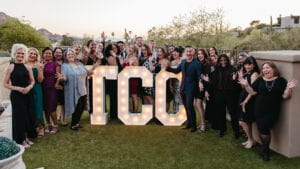When collaborating with others, at first blush, intellectual property (“IP”) joint ownership seems like a really good idea. After all, it seems fundamentally fair for collaborators in a joint development effort to share the fruits of their labor equally. Fifty-fifty. However, what seems ultimately fair at first results in many unintended consequences, almost always leaving one party sorely disappointed.
There are three oft-repeated scenarios at the heart of disputes over IP ownership. One occurs when collaborators plunge into their project with no agreement. Another occurs when they have a “hand-shake deal” over how ownership, profits and expenses will be divided. And, a third arises when the parties actually do execute a written agreement, but it falls short in ways that can only be transmogrified in fierce litigation. What unites these scenarios is an unclear division about who owns what, leading to needless expense, protracted litigation, opportunity for mayhem and uncertain outcomes – none of which the parties intended when they heartily entered into their joint ownership arrangement.
Joint ownership is a complicated subject that could fill volumes. This article offers a bird’s-eye view explaining why most IP lawyers when confronted with the prospect of joint IP ownership say, “Don’t do it.”
No Agreement

If joint creators do not have an agreement governing IP ownership, then the law decides who owns the IP, but the answers can be far from clear. The rules differ as between joint inventors for patent-eligible inventions and joint authors for copyrighted material. In the case of patents, joint inventors (presumed to be joint owners) each own an undivided interest in the entire invention, even if the contribution of one inventor is minor. In the case of copyrights, however, joint creators can only be joint authors (also presumed to be joint owners) if they intend that their works be “inseparable or independent parts of the unitary whole.” In that case, unlike with patents, small creative efforts may not rise to the level of joint authorship, leaving one of the “authors” without any ownership interest. And, in the case of patents, since inventorship of an entire patent is determined based on inventive contribution to a single claim, an inventor can end up with an outsized share of patent ownership rights compared to the inventor’s actual inventive contribution.
Even if it is clear the parties are co-owners, for a joint development project involving several different types of intellectual property, it can be difficult to ascertain what joint ownership actually means in real terms. While joint patent owners can each individually make, use, sell and license the patented invention without having to account to the other joint owners, in the case of copyright, joint owners can fully exploit the copyrighted works, but they do have to account to the other joint owners for the profits from such exploitation. A potential downside of joint exploitation is that one co-owner can license to a third party – even a fierce competitor objectionable to another co-owner. In addition, without an explicit agreement, it could be very difficult to determine who is owed what in the case of technology subject to both patent and copyright protection, such as any software-implemented control system, for example. The rules also diverge when it comes to enforcement against infringers. In the case of patents, a co-owner cannot sue for patent infringement without the consent of the other co-owner(s) to join as plaintiffs, but a copyright owner of a registered copyright work can.
The Ethicon case, supra, illustrates what can happen in the absence of any agreement. There, Yoon and Choi collaborated on a surgical trocar device, without an agreement; Choi eventually withdrew from the collaboration. Unbeknownst to Choi, Yoon applied to patent the trocar invention as a sole inventor without naming Choi. The patent issued and Yoon exclusively licensed it to Ethicon. As exclusive licensee, Ethicon sued U.S. Surgical for infringing the patent. When U.S. Surgical learned about Choi’s contribution as a co-inventor, it obtained a retroactive license from Choi. U.S. Surgical then moved to correct the patent to add Choi as an inventor. The lower court agreed, added Choi as an inventor and then dismissed Ethicon’s lawsuit based on Choi’s license to U.S. Surgical. The Federal Circuit affirmed, but upheld the dismissal of the lawsuit on different grounds.
The Federal Circuit affirmed naming Choi as a co-inventor and therefore Choi’s right as a co-inventor to issue licenses of his own. The Federal Circuit also upheld the dismissal. It did so based, not on the license from Choi, but rather on the fact that Choi as a joint owner of the patent had not joined in the lawsuit against U.S. Surgical following well-settled law that all co-owners of a patent must join as plaintiffs to sue for infringement.
This situation certainly did not turn out the way Yoon intended. Whereas Yoon thought he owned the patent outright, that was not the eventual outcome. Without an express agreement governing their collaboration, Yoon ended up having to share the patent with Choi, such that Choi could fully exploit the invention without having to account to Yoon or get his permission. And, since Ethicon did not end up with a truly exclusive license, Yoon may also have subjected himself to liability from Ethicon depending on the terms of their license agreement.
The Hand-Shake Deal
An oral agreement, or hand-shake deal, has the same proof problems in the IP context that it has in any other context; however, it is made worse against the backdrop of IP ownership issues. When friends collaborate on an invention and then shake hands on their “agreement,” the situation typically ends badly – always with one party sorely disappointed. “As is often not uncommon with friendships cum business relationships, . . . harmony [does] not prevail. . . .” Windsurfing International , Inc. v. Fred Osterman GmbH, 1986 WL 285, *1 (S.D.N.Y. June 23, 1986). The battle over ownership rights to the windsurfer is a prime example.
Working in their garages in the 1960’s, two friends, Drake and Schweitzer, collaborated to invent the windsurfer and patented it. Drake thought they were partners, agreeing to split profits and losses; Schweitzer, didn’t and, unbeknownst to Drake, formed his own company and separately licensed the invention, all while negotiating to buy out Drake’s interest in the patent, which he eventually did. Drake thought their partnership obligated Schweitzer to disclose the licensing deal to him before buying out his interest. Drake sued, seeking rescission of his patent assignment to Schweitzer. The case took years. While Drake actually proved the existence of the partnership at trial, the court nonetheless dismissed the case on statute of limitations grounds, finding that the complex set of facts and circumstances also put Drake on notice of certain facts that would have caused a prudent person to inquire further about the licensing deal sooner than he did, meaning that Drake sued too late. Drake lost out, while Schweitzer’s company flourished — at least for a while.
Imperfect Agreement
Sophisticated companies are not spared from problems with intellectual property joint ownership — even when there is a written agreement. One such example arose from a joint technology development agreement (“JDA”) over digital audio file compression inventions (for MP3 technology).
There, employees of AT&T (now “Lucent”) and Fraunhofer Gesellschaft (“Fraunhofer”) collaborated on this technology under a JDA in which each company retained separate ownership of their Existing Technology developed before April 1989. However, New Work developed after April 1989 was “treated as joint work,” such that all IP rights were jointly owned and each party could make nonexclusive use of New Work, including granting nonexclusive licenses. Frauhofer granted Microsoft licenses to various patents covering the technology, while Lucent sued Gateway and Dell for patent infringement in consolidated cases; Microsoft intervened. Although Lucent argued that the patent claims at issue covered only Lucent Existing Technology, the trial court disagreed, finding that two patent claims covered New Work, which Lucent and Frauhofer jointly owned under the JDA. Since Frauhofer was a joint owner and Lucent sued without them, the trial court held that Lucent lacked standing to sue for patent infringement and dismissed the case. The Federal Circuit affirmed.
Lucent clearly lost out here, but, in hindsight, the JDA could have addressed this problem from the outset by requiring one joint owner to consent to and participate in an infringement suit filed by the other. In the alternative, the JDA could have set out a different ownership structure whereby one party actually owned the patents with generous license rights to the other. Other types of ownership structures could also have been used to avoid joint ownership of the same intellectual property.
Thus, unclear divisions about who owns what can lead to countless problems and unintended consequences, never with a certain outcome. However, a clear and unambiguous written agreement with strong and detailed definitions for the various types of intellectual property and an ownership structure without overlapping ownership boundaries can go a long way toward forestalling problems down the road.
Susan E. Chetlin is Of Counsel to Burch & Cracchiolo, P.A. in Phoenix, AZ. Sue is a Registered Patent Attorney and provides the full range of intellectual property protection legal services to her clients, including patents, trademarks, copyrights, trade secrets and IP ownership and disputes using an integrated approach.




